Matthew Beaufort, a specialist in art history and Associate Professor of Humanities at Maharishi International University (MIU), takes us on an exploration of two masterpieces of Renaissance art. To experience these art works and many others in person, enjoy Professor Beaufort’s MIU Tour of Italy, May 2020, featuring sightseeing, boutique shopping, and delicious Italian food. Celebrate la dolce vita—the sweet life—with other TM® Meditators, their families, and friends! People who do not practice the TM technique are also welcome on this tour.
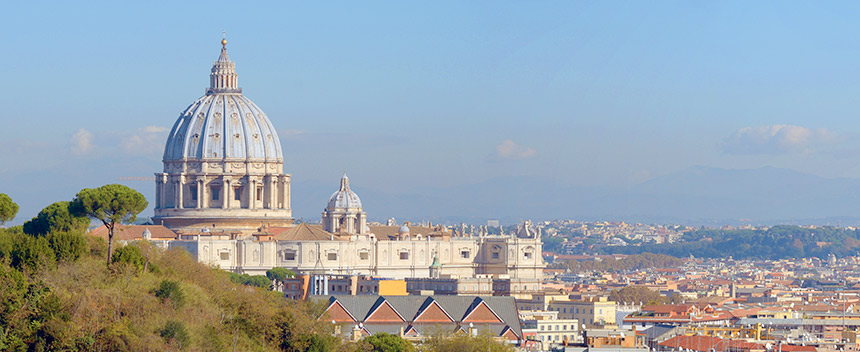
A view of Rome and the Basilica of the Vatican, an important locale for exploring Renaissance art (photo by Livio Andronico/CC 4.0)
Why does the beauty and appreciation of some art transcend time? Why does Michelangelo’s The Creation of Adam, one of the most powerful images from the celebrated Sistine Chapel, attract more than six million visitors a year and profoundly inspire a wide range of people? Deep within the consciousness of every individual, at the more silent or transcendental levels, are universal qualities shared by all people. Great artists like Michelangelo experience these universal qualities of consciousness and express them in the cultural language of their time.
In this article, as in my classes at Maharishi International University in Fairfield, Iowa, and on my guided tours, I reveal how great art relates to our experiences with the Transcendental Meditation® technique, through which we are unfolding universal qualities of consciousness in our lives.
Great art evokes transcending to subtler levels of awareness. Because we are transcending every day with the TM technique, we can more deeply appreciate the beauty and wisdom crystallized in art.
Deep within the consciousness of every individual, at the more silent or transcendental levels, are universal qualities shared by all people. Great artists like Michelangelo experience these universal qualities of consciousness and express them in the cultural language of their time.
Raphael’s Painting Illuminates Universal Aspects of Consciousness Shared by Everyone
Italian Renaissance artists like Michelangelo and Raphael expressed universal aspects of consciousness through Christian and pagan symbolism, which was inspired by the ideas of Plato as revived in Neo-Platonism.
Renaissance means “rebirth.” In the European Renaissance, the classical art forms and ideas of ancient Greece and Rome were reborn. This study of classical antiquity was then known as “humanism.”

Raphael’s The School of Athens, a fresco in the Papal Palace of the Vatican
For example, let’s look at a painting on the wall of Pope Julius II’s private library in the Papal Palace of the Vatican. Raphael’s The School of Athens represents one branch of learning: Philosophy. This enormous fresco (16.7 X 25 feet) was completed between 1509 and 1511. On the other walls are paintings of poetry, law, and Christian theology. In this single room we see the synthesis of Christianity and humanism that was sought by Renaissance thinkers.
In the center of The School of Athens stand Plato and Aristotle, surrounded by other ancient philosophers and scientists. The word “philosopher” originally meant a lover of wisdom. Let’s see what we can learn from them.
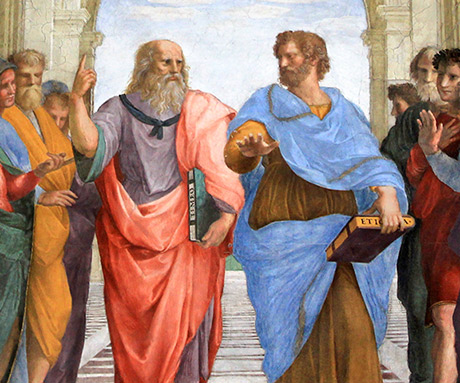
Plato and Aristotle, in a detail from The School of Athens
Aristotle, dressed in blue, on the right, stretches his hand out horizontally, symbolizing his emphasis on gaining knowledge of the outer world—the beginning of Western science. However, he, like his teacher Plato, understood that knowledge of external phenomena was not sufficient for wisdom and fulfillment in life. Aristotle extolled the knowledge of the transcendental “unmoved mover,” the non-changing source of all change.
We can relate Aristotle’s insights to our own lives. We know we must gain knowledge of the world, such as expertise in our professions, to be successful. Yet many people find that such expertise and success are insufficient for fulfillment in life. In fact, the demands of learning and achievement can often be stressful and taxing to our health.
Aristotle extolled the knowledge of the transcendental “unmoved mover,” the non-changing source of all change.
Renewing Ourselves by Contacting the “Unmoved Mover” Within
Fortunately, we can transcend the outer commotion of the world during our TM practice to enjoy a less active, less changing aspect of ourselves. At times, when there is no mantra and no thoughts, we may experience a completely silent, non-moving state of awareness. TM Founder Maharishi Mahesh Yogi called this state “pure consciousness,” which he explained is the non-changing source of all change. We can see this is similar to Aristotle’s “unmoved mover.” Even if we don’t experience pure consciousness clearly, settling down in the TM technique renews our minds and bodies, supporting a healthy balance between the inner and outer aspects of life.
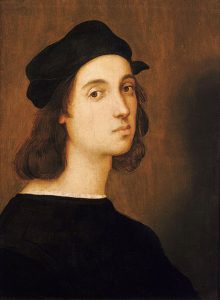
A self-portrait by Raphael at age 23 in 1506
Raphael explores this relationship between inner and outer in how he represents Plato and Aristotle. As seen in the detail above, Plato, dressed in red on the left, points emphatically upward. This symbolizes his emphasis on higher knowledge and higher consciousness. He taught that knowledge of the transcendental reality was higher and more valuable than knowledge of the outer world. To personify Plato, Raphael used the likeness of Leonardo da Vinci, who exemplified the Renaissance man, a master of all fields of knowledge.
Plato asserted that the transcendental reality contained the Beautiful, the True, and the Good. These ideas, like the transcendent, always exist. The philosopher’s task is to recollect or remember the transcendental divine, which he has forgotten while in the earthly realm. Through this recollection he is able to recover direct knowledge of the true causes and sources of all things in the external world.
Plato taught that cultivating knowledge of the transcendent would eventually result in wisdom, virtue (right action in harmony with the cosmos), and fulfillment.
How to Experience the Transcendental Source of Wisdom
We can connect Plato’s insights to our own practice of the Transcendental Meditation technique. When our minds settle down to quieter, more expanded levels of awareness, we begin to gain direct knowledge of a transcendental aspect of consciousness, which TM Founder Maharishi Mahesh Yogi explained is the source of all thought and creativity.
Plato taught that cultivating knowledge of the transcendent would eventually result in wisdom, virtue (right action in harmony with the cosmos), and fulfillment.
“All thought and activity begin from this silent level, where the mind is not thinking—it is only awake in itself. From silence arises thought, action, achievement, and fulfillment.” —Maharishi
Similarly, Maharishi taught that repeated experiences of transcending through regular TM practice would lead to greater understanding of ourselves. Then we are able to act more in harmony with nature and enjoy greater inner and outer fulfillment.
Maharishi explained that the ability to act spontaneously in accord with natural law “is achieved through the TM technique, when the active mind settles down to a state of quiet awareness. This is pure consciousness or the simplest form of awareness. All thought and activity begin from this silent level, where the mind is not thinking—it is only awake in itself. From silence arises thought, action, achievement, and fulfillment.”1
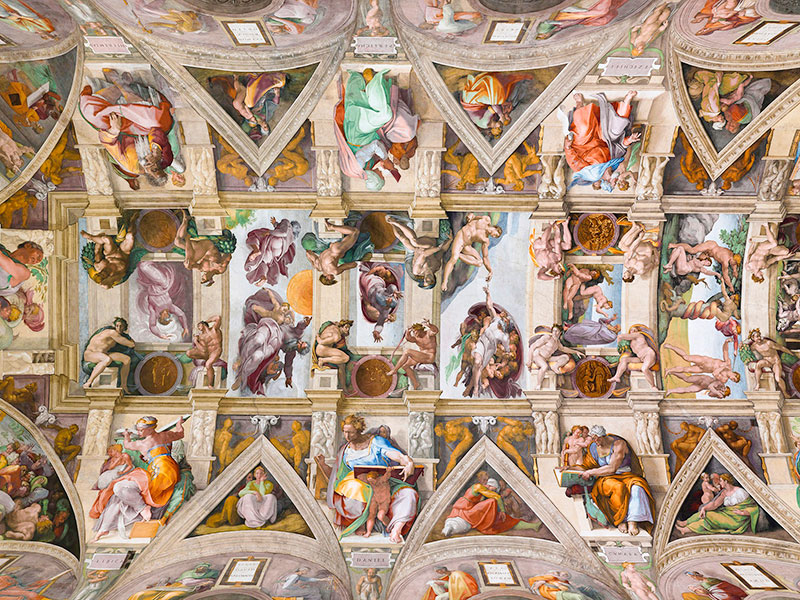
The ceiling of the Sistine Chapel painted by Michelangelo, with The Creation of Adam at the center
Creative Inspiration in Michelangelo’s Creation of Adam
Let’s look now at Michelangelo’s Creation of Adam, which can be seen on the ceiling of the Sistine Chapel in the Vatican. This work was also commissioned by Pope Julius II, and Raphael was painting The School of Athens only a hundred yards from where Michelangelo was painting The Creation of Adam!

Michelangelo as Heraclitus, in a detail from Raphael’s The School of Athens
In fact, to pay tribute to Michelangelo, Raphael used his likeness to portray the pre-Socratic philosopher Heraclitus in The School of Athens. He also borrowed some of Michelangelo’s visual ideas from the Sistine Ceiling, such as contrapposto, or turning a human figure in different directions simultaneously, as he did for Heraclitus.
The Creation of Adam was inspired by Genesis, the first book of the Bible. According to this sacred text, God created the first human beings in his own image. In Michelangelo’s interpretation, the Creator, a superhuman, grandfatherly figure, stretches out forcefully yet tenderly. He almost touches Adam’s outstretched hand as he infuses him with the breath of life.
What personal meaning might this image have had for the artist? Michelangelo and many of his contemporaries believed he was divinely inspired—that he received inspiration and ideas from a universal power. The figure of the Creator in this painting embodies that cosmic source of creativity. The figure of Adam may symbolize Michelangelo himself as he receives creative inspiration from a higher power.
Notice that Adam is reclining, yet he is not asleep. His eyes are wide open as he looks into the eyes of his Creator. Adam’s body is resting and relaxed, yet his mind appears fully alert. This may reflect the state of body and mind Michelangelo experienced when he received creative inspiration: extremely relaxed and receptive, yet intensely alert, a state of heightened awareness.
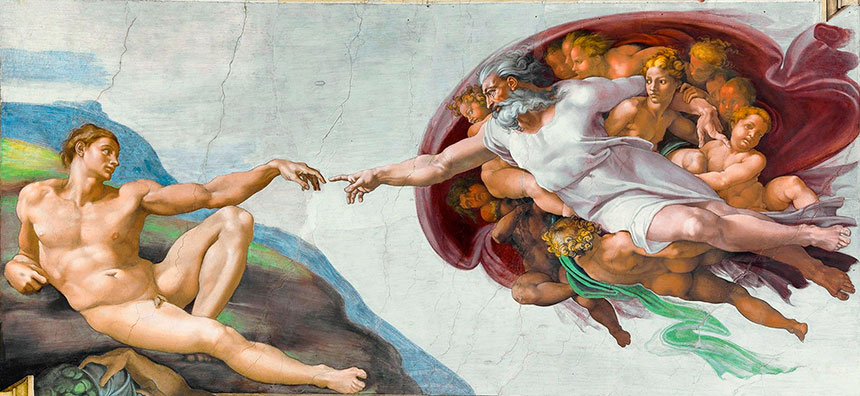
Michelangelo’s The Creation of Adam in the Sistine Chapel at the Vatican
Adam’s body is resting and relaxed, yet his mind appears fully alert. This may reflect the state of body and mind Michelangelo experienced when he received creative inspiration: extremely relaxed and receptive, yet intensely alert, a state of heightened awareness.
How to Live a Creative and Inspired Life
The state of body and mind mirrored by Adam may remind us of what we experience during the Transcendental Meditation technique—our body is deeply rested and relaxed, yet our mind is alert. Scientific researchers have named this state “restful alertness.” Of course, when we meditate, our eyes are closed. Following our TM practice, this restfully alert state carries over into our activity.

Have you ever received creative inspiration or had innovative ideas after meditating? Do they seem to come from a part of your awareness that is bigger or deeper? Where do all our countless thoughts come from?
Maharishi pointed out that deep within everyone is the source of all thought and creativity: “The area from where so many innumerable thoughts originate must necessarily be an inexhaustible reservoir of energy and intelligence.”2 He also stated that, “Bringing our consciousness repeatedly to pure creativity and intelligence eventually brings pure creativity and intelligence into all our conscious life.”3
“The area from where so many innumerable thoughts originate must necessarily be an inexhaustible reservoir of energy and intelligence.”
—Maharishi
We can culture a creative and inspired life through regular practice of the TM technique and its advanced programs. To support your regular daily practice, consider scheduling a TM Checking session with a Certified Teacher at your local Center.
You may also enjoy attending a one-day or weekend TM Retreat, where you’ll enjoy deeper experience and knowledge of the development of consciousness in a restful, pleasant environment. Many people find that TM Retreats give an added boost to the benefits of their daily TM practice.
To accelerate your growth, you can learn the TM-Sidhi® program. This program cultivates the ability to think and act spontaneously from the transcendental field of awareness.
For more information on all TM follow-up and advanced programs, visit EnjoyTM.org.
Being with other TM practitioners, such as at Advanced Meetings, TM Retreats, and other events sponsored by your local TM Center, is enjoyable and supportive to one’s personal growth. Joining one of MIU’s travel tours is a way to experience the world with the fresh perspective of the Consciousness-Based® approach to knowledge.
We invite you to join us on the MIU Tour of Italy, May 2020! For information, visit tours.miu.edu or write to me at mbeaufort@miu.edu.
For more information about Consciousness-Based education at Maharishi International University, visit MIU.edu.
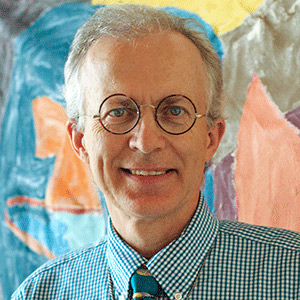
Matthew Beaufort, Associate Professor of Humanities at Maharishi International University (MIU), has organized four tours of Italy as well as trips to France, England, and Spain. He has two masters degrees; studied art history and Italian in Florence; and edited, introduced, and contributed to the book Consciousness-Based Education and Art: Developing the Infinite Creativity of Every Student (MIU Press, 2012).
Notes
2. Maharishi Mahesh Yogi, Creativity and Creative Intelligence, audiotaped lecture 24 July 1971, Amherst, MA. Quoted in “Maharishi’s Principles of Art and Art Education,” Consciousness-Based Education, p. 232.
3. Maharishi Mahesh Yogi, “A Message from His Holiness Maharishi Mahesh Yogi,” Creative Intelligence, 1, 2-5 (a journal published by the TM organization in 1973, no place of publisher given). Quoted in “Maharishi’s Principles of Art and Art Education,” Consciousness-Based Education, p. 234.


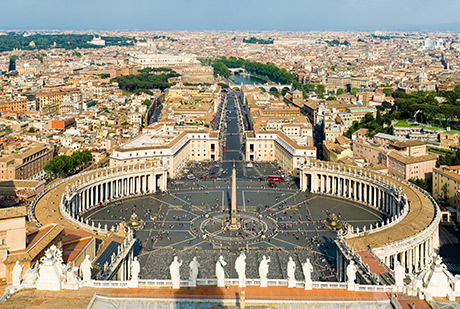
Comments
You may also like
Creativity & the Arts
Continuous Creation
Artist Kuno Vollet creates iconic objects with fullness of emptiness at their center. “TM influenced my art from the beginning, because you have to be so relaxed, not tense, when you do your work… I get into a deeper and deeper state, and it’s just a flow, where there is no disturbance. The art is just being created.”
Creativity & the Arts
Lawrence Sheaff: An Artist Giving Back
Lawrence Sheaff worked with Maharishi Mahesh Yogi as a visual artist for 18 years. When he returned to his own work he wanted to combine the two things he loved most: Vedic Science and painting.
Creativity & the Arts
A Man of Steel and Silence: Jeroen Stok Sculpts Stunning Public Works
A light bulb turning on inside a character’s head indicates a brilliant idea. For Dutch artist Jeroen Stok, a light bulb was the idea that set him on his career path as a sculptor and installation artist.
Creativity & the Arts
Architect Bing Thom Speaks on TM and Creativity
Bing Thom is an award-winning architect and recipient of Canada’s celebrated Golden Jubilee Medal, honoring Canadians who made a significant contribution to the nation. TM supports his work.